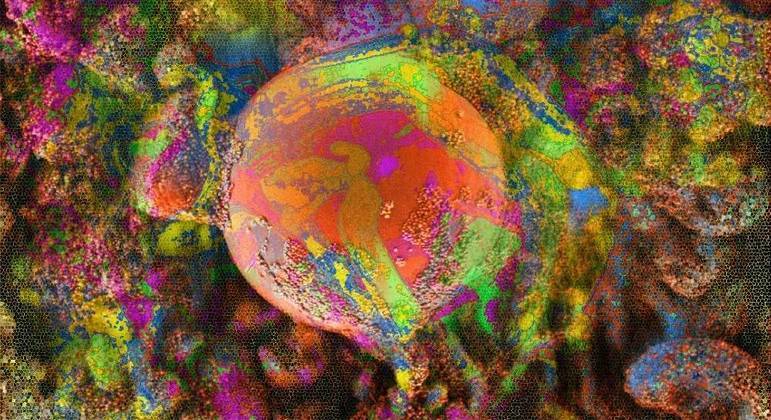Plastic arts and discoveries made by microscopes can, at first, be two areas that are apparently unrelated. However, in the past few years a so-called nanoart has emerged, as a kind of artistic production made from images collected by scientific instruments.
Also read: NFT: Understanding the Digital Record Affecting the Art World
Nanoart can be understood as a way to link art, science and technology with the production of digital works in most cases. They are created by black and white images captured by scanning electron microscopes, which when you reach the artists come to life and colors with the help of computer programs.
“In my case, after computer-drawing, I print and then do another coloring with acrylic paint so that the work acquires more volume and more spirit,” highlights Ino Longo, a Brazilian plastic artist who has produced nanoart since 2012.
Enio points out that it is one of the only artists working with nanoart in Brazil today, and this is due to the fact that digital art, here in the country, is still not well understood as something of value in the art scene.
“Nano art in Brazil is still very oriented towards universities and the scientific world. The artistic world has not yet absorbed this kind of work. I think artists in general still do not accept it much because they believe that plastic art should always be on screen,” says the artist. .
First contact
The digital arts producer had his first contact with this new art discipline when his brother, Elson Longo, Director of the Center for Development of Functional Materials (CDMF) at the University of Sao Carlos (UFSCAR), sent him some work by a foreigner. Artists.
At that time, Inoue, who had already produced work in the range considered more traditional for the plastic arts, began to research and implement some work over the microscopic images sent by his brother.
“My brother sends me raw materials, and I take pictures to the computer, and I increase the pixels because they reach a very small scale and then I start drawing in the program through the layers,” he points out.
In 2015, his work at Pinacoteca de São Paulo displayed works made with ingredients used in beer production.
Read more: See 7 photos of the moon that astronauts took from space
In 2017, the artist had the opportunity to present some of his work at the group exhibition Exposition Inovanças: Creations for Brazilians, held at the Museum of Tomorrow, in Rio de Janeiro. In addition, over the years he has participated in nano-art exhibitions in countries such as Greece, Israel and Romania, all sponsored by nano artist Chris Urfsko.
Due to its success in this field of fine art, last year Enio was invited to participate in the digital exhibition France-China Arte Expo. He pointed out that “the French artist Jean-Jacques saw my recent works and invited me to participate in the exhibition in 2020. In this year’s edition, the invitation declined again and I decided to introduce nano-art.”
“The nanoscale art that I picked up for this event focuses on interest in the Amazon rainforest. I don’t make art so that it’s just a painting, I always want it to have some connection to the current context, it’s not just an ornament,” he adds.
Current and nanoart topics in Brazil
Since it always strives to produce these arts based on current themes, Enio and other colleagues at CMDF have recently started producing some videos in which nanoart work is being inserted alongside scientific figures. The goal, he said, is to restore credibility to science at a time when many questions have become during the pandemic.
In these products, the artist also includes information about care that people should take to avoid contracting the Coronavirus, such as staying home, not being crowded and always washing their hands.
Enio believes that nanoarte in Brazil is still in its infancy towards further recognition, especially among plastic artists. However, he thinks this will be an ant’s work of those who produce some kind of digital art here in the country.
“At the France and China expo, for example, I may not own nanotechnology, but I think that by putting a seed here, there, this movement can grow gradually,” he said.
The artist also realizes that it is normal for new works to be rejected at first due to the difficulty we face in receiving new things. Nevertheless, he believes in the power with which art must somehow change the world.
“We always need to fight for a better world, add a little bit of color, make it less gray. Art in general has that role,” said Enyo Longo.
* Intern R7 Under the direction of Fabio Florey

“Wannabe internet buff. Future teen idol. Hardcore zombie guru. Gamer. Avid creator. Entrepreneur. Bacon ninja.”

